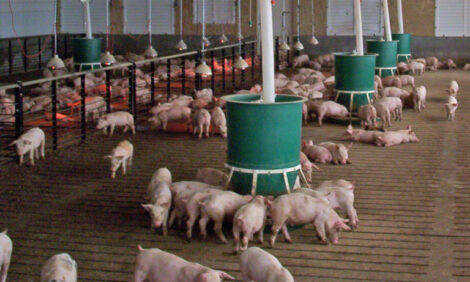



Effects of Low Protein Diets on Lean Genotype Pigs: Growth, Feed and Nitrogen Intake and Fat Indicators
Feeding a low-protein diet supplemented with lysine to pigs from 40 to 115kg resulted in growth similar to the normal protein control diet but with more intramuscular fat, according to researchers based in the UK and Italy. However, six per cent more feed was needed to produce 1kg of liveweight gain over the period for the lysine-supplemented pigs than for the controls, which the authors attributed to deficiencies of other amino acids.The EU nitrate directive and the increasing cost of protein sources are leading farmers to reduce the nitrogen content in livestock feed, say Lutz Bünger of SAC in Edinburgh, UK and co-authors there and other organsiations in the UK and Italy. In their paper presented at the 20th International Symposium 'Animal Science Days' in Slovenia in September 2012, they explain that UK pig production often employs high-protein rations to ensure high growth rate and low fat deposition.
The aim of the work they reported was to compare the performance of pigs of a lean genotype fed with a conventional (C) or two low-protein (LP) diets, with (LP1) or without (LP2) lysine supplementation.
A total of 64 animals on each diet were reared from 40 to 115kg and fed ad-libitum. Liveweights and feed intake were recorded and after slaughter backfat (P2 site) thickness was measured and samples of longissimus muscle were analysed for total fatty acids. Pen-based data were analysed examining diet and batch as main factors.
There were no significant diet effects on feed intake. Pigs on LP2 had a lower average daily weight gain and higher feed conversion ratio (FCR) than C or LP1 from 60kg onwards.
Between diet strategies, there were no significant differences in backfat thickness but body fat deposition was higher in the LP2 group, followed by the LP1, and C the lowest.
Results confirm that the LP1 strategy allows growth performance similar to the C diet but with 11 per cent more intramuscular fat , concluded the researchers. Pigs on LP2 diet show an increase in body fat and intramuscular fat, although subcutaneous fat thickness was little affected. LP1 results indicate that reduced nitrogen intake (C versus LP1 by 11 to 15 per cent) can be achieved without compromising the growth performance. However, added Bünger and co-authors, feed conversion was significantly poorer (by six per cent) than the C diet, probably due to amino acids deficiencies.
Reference
Bünger, L., N. Lambe, K. McLean,, G. Cesaro, G. Walling, H. Whitney, S. Jagger, P. Fullarton, N. Penlington, C. Maltin, J. Baytun and J. Wood. 2012. Effects of low protein diets on lean genotype pigs – growth, feed/N-intake and fat indicators. Proceedings of 20th International Symposium 'Animal Science Days'. Kranjska gora, Slovenia. 19-21 September 2012. Acta argiculturae Slovenica, Supplement 3, 57–60.
This was a Sustainable Livestock Production LINK project funded by Defra, BPEX, QMS, JSR Genetics, Tulip, ABN and Forum Products.
Further ReadingYou can view the full report by clicking here. |
November 2012








